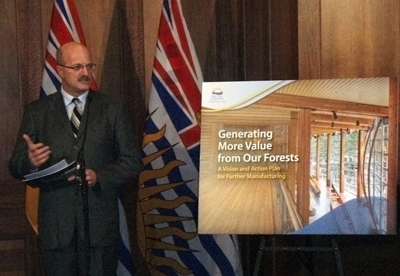Government and industry have been long time partners working to create a healthy forest industry in B.C. Great strides have been made by taking steps to diversify forest product markets especially in emerging markets like China, and recent gains in market share there are pointing to our success.
In 2010 exports to China reached $342 million and have grown 10-fold in just seven years, increasing to 3.3 million cubic metres from 368,000. More than 10 B.C. sawmills and a thousand employees are dedicated to producing lumber for China alone.
This is not accidental. Market growth in China is the direct result of strategic investment in product development and design, technology transfer, and sales and marketing by a partnership that includes the forest industry, the federal government and the provincial government through Forestry Innovation Investment.
However, instead of the provincial government increasing FII’s funding to further grow these vital product and market development programs worldwide, its funding is steadily declining, dwindling from a high of $22.5 million to its current budget of $18.5 million.
A few weeks ago in January 2011, the Ministry of Forests, Mines and Lands released its third status update on the Working Roundtable on Forestry report that includes a vision, six key priorities, and 29 recommendations.
One of the key priorities identified in the report is “Embracing Innovation and Diversification”. Recommendation #18 states: “We should continue to diversify forest product markets with particular emphasis on emerging markets such as China, ensuring that marketing efforts are sustained, coordinated and based on what end users want.”
The goal for the British Columbia forest industry is to achieve “a vibrant, sustainable, globally competitive forest industry that provides enormous benefits for current and future generations and for strong communities.”
Markets like China hold the answer. With 8 million housing starts annually, if we were to capture just 10% of that market share we’d match the total U.S. market in its former glory days.
But for this to happen, when the Liberal Party elects its new leader this month, he or she will have to believe in investment in B.C.’s forest industry, and support product and market diversification by putting the money back where the most potential growth is.
For the full report “Implementation of The Working Roundtable on Forestry’s Recommendations” visit:
http://www.for.gov.bc.ca/mof/forestry_roundtable/20110120-RoundtableStatusUpdate.pdf



 Posted by coastforest
Posted by coastforest 

